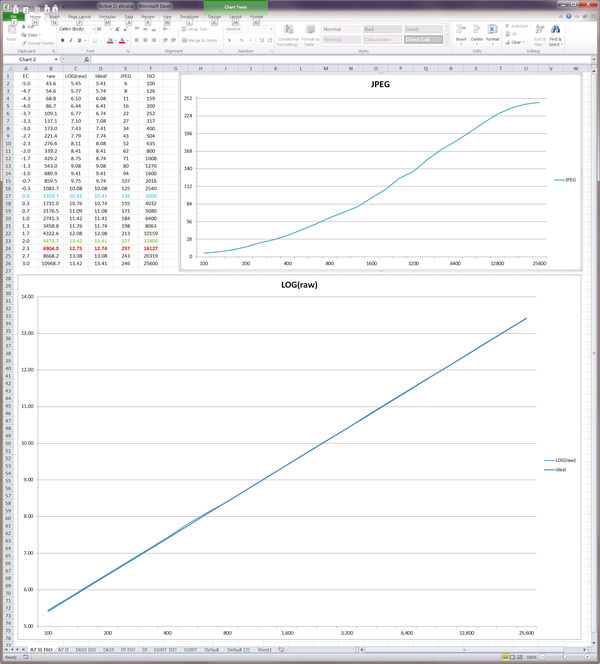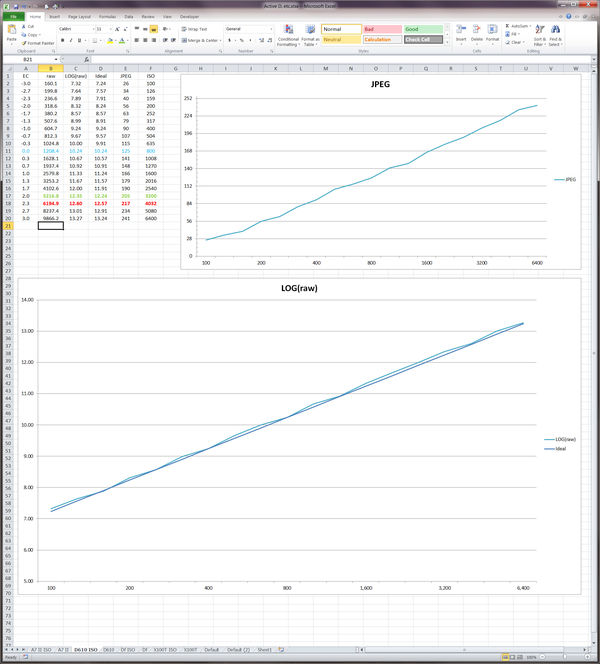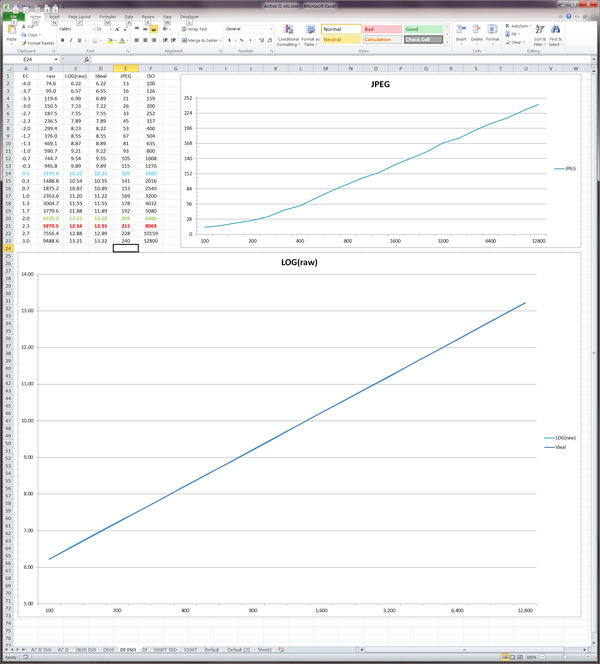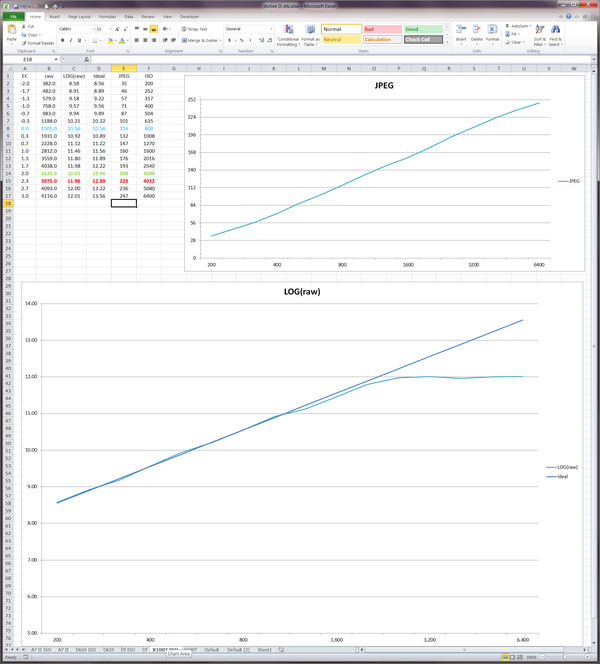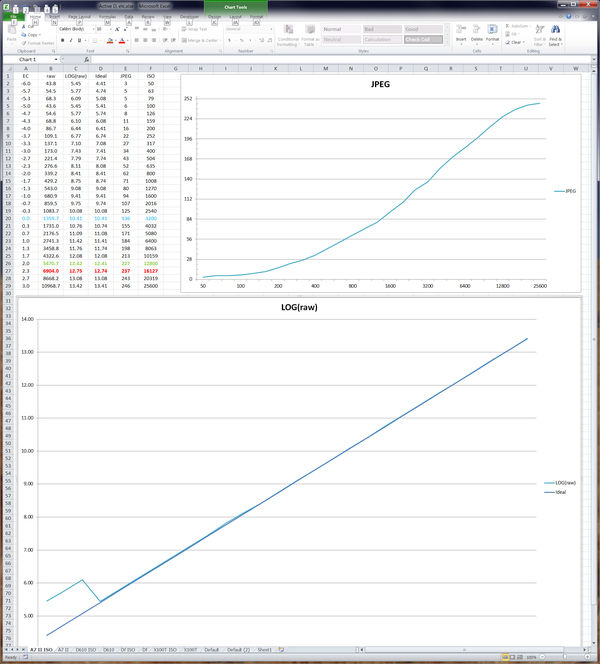Linearity in the raw file over a camera's normal range
Oct 12, 2019 11:19:47 #
In another thread (link in next post) I examined the relationship between raw data and the camera's default JPEG when using base ISO and looking at a nine stop dynamic range.
This time I am looking at a fixed exposure while covering the camera's normal range from base ISO through the highest natural ISO and I came across a couple of surprises:
1. The Nikons clearly state the ISO range - 100 to 6400 for the D610, 100 to 12800 for the Df. Both of them provide extended high and low ISO ranges and make it clear that they are not normal.
2. The A7 II has a base ISO of 100 and a high limit of 25600. They also go below base ISO to 50 but they do not make it clear that 50, 64 and 80 are not normal.
3. The Fuji X100T provides a range from 200 through 6400. However, they don't make it clear that above ISO 1600 the relationship between the raw data and the JPEG is not normal.
I tested each camera by picking an exposure that would yield a normal image three stops below the camera's normal high ISO. That is 3200 for the A7 II, 800 for the D610, 1600 for the Df and 800 for the X100T (only because I had not yet discovered that the end of the normal range is actually 1600).
I thought I would find a deviation between the linearity of the raw data and an ideal line. I was surprised by the consistency of three of the cameras. Only the X100T revealed an issue.
If this information is of no interest to you, please move to another topic without commenting.
Thank you.
This time I am looking at a fixed exposure while covering the camera's normal range from base ISO through the highest natural ISO and I came across a couple of surprises:
1. The Nikons clearly state the ISO range - 100 to 6400 for the D610, 100 to 12800 for the Df. Both of them provide extended high and low ISO ranges and make it clear that they are not normal.
2. The A7 II has a base ISO of 100 and a high limit of 25600. They also go below base ISO to 50 but they do not make it clear that 50, 64 and 80 are not normal.
3. The Fuji X100T provides a range from 200 through 6400. However, they don't make it clear that above ISO 1600 the relationship between the raw data and the JPEG is not normal.
I tested each camera by picking an exposure that would yield a normal image three stops below the camera's normal high ISO. That is 3200 for the A7 II, 800 for the D610, 1600 for the Df and 800 for the X100T (only because I had not yet discovered that the end of the normal range is actually 1600).
I thought I would find a deviation between the linearity of the raw data and an ideal line. I was surprised by the consistency of three of the cameras. Only the X100T revealed an issue.
If this information is of no interest to you, please move to another topic without commenting.
Thank you.
Oct 12, 2019 11:22:53 #
The previous thread is Does the JPEG discard highlight information at the high end of the raw file ?
Here are the results from the four cameras. Throughout the cameras' normal ranges the raw file values increase uniformly with each increase in ISO.
The only surprise was the discovery that the normal range for the Fuji X100T appears to end at 1600. All ISO settings above that are fudged by keeping the raw values at about the same level.
Here are the results from the four cameras. Throughout the cameras' normal ranges the raw file values increase uniformly with each increase in ISO.
The only surprise was the discovery that the normal range for the Fuji X100T appears to end at 1600. All ISO settings above that are fudged by keeping the raw values at about the same level.
Oct 12, 2019 13:13:47 #
a6k
Loc: Detroit & Sanibel
Scotty, just to make sure I understand what you did, is this correct?
1. pick a manual exposure setting (lens and shutter speed).
2. make numerous exposures with that lens and shutter setting but varying the ISO setting progressively.
3. use RawDigger values and Excel to examine the linearity of the results.
4. repeat for each camera.
Do I have that right?
1. pick a manual exposure setting (lens and shutter speed).
2. make numerous exposures with that lens and shutter setting but varying the ISO setting progressively.
3. use RawDigger values and Excel to examine the linearity of the results.
4. repeat for each camera.
Do I have that right?
Oct 12, 2019 13:32:55 #
a6k wrote:
Scotty, just to make sure I understand what you did, is this correct?
1. pick a manual exposure setting (lens and shutter speed).
2. make numerous exposures with that lens and shutter setting but varying the ISO setting progressively.
3. use RawDigger values and Excel to examine the linearity of the results.
4. repeat for each camera.
Do I have that right?
1. pick a manual exposure setting (lens and shutter speed).
2. make numerous exposures with that lens and shutter setting but varying the ISO setting progressively.
3. use RawDigger values and Excel to examine the linearity of the results.
4. repeat for each camera.
Do I have that right?
That's it in a nutshell.
What brought this to mine was a discussion on a separate thread regarding whether changing the ISO has an unpredictable effect on the raw data. Well, it's apparently very predictable for the Nikons and Sony that I tested.
The test also revealed that Fuji is doing some weird things with the X100T to make it appear to have an ISO range that is greater than 200 to 1600. I was planning to stay below ISO 2000 anyhow.
It stemmed from a discussion about ISO invariance. It would seem that, since the raw file records values proportionally within the normal ISO range, any issues with ISO invariance come from the processing of the raw data to create a JPEG. It doesn't happen with a JPEG created on the computer using the same raw data. In other words, it's a camera software issue, not a sensor problem.
Of course, I don't have access to a Canon where the ISO seems to jump up and down in the 1/3 stop increments between whole stop steps.
Oct 13, 2019 08:56:26 #
selmslie wrote:
... 2. The A7 II has a base ISO of 100 and a high limit of 25600. They also go below base ISO to 50 but they do not make it clear that 50, 64 and 80 are not normal. ...
In Sony's case it's only a sin of omission. Unlike Nikon, they just did not reveal that the extended ISO settings below base ISO are fudged.
Other than that, they have a straight sequence of raw data just like the Df.
If you want to reply, then register here. Registration is free and your account is created instantly, so you can post right away.

